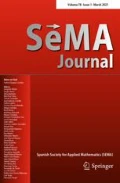Poya, Roman; Ortigosa, Rogelio; Gil, Antonio J. Variational schemes and mixed finite elements for large strain isotropic elasticity in principal stretches: Closed‐form tangent eigensystems, convexity conditions, and stabilised elasticity Journal Article In: Numerical Meth Engineering, vol. 124, no. 16, pp. 3436–3493, 2023, ISSN: 1097-0207. Abstract | BibTeX | Tags: Applied Mathematics, DICOPMA, General Engineering, Numerical Analysis | Links: Ortigosa, Rogelio; Martínez-Frutos, Jesús; Mora-Corral, Carlos; Pedregal, Pablo; Periago, Francisco Mathematical modeling, analysis and control in soft robotics: a survey Journal Article In: SeMA, 2023, ISSN: 2281-7875. Abstract | BibTeX | Tags: Applied Mathematics, Control and Optimization, DICOPMA, Modeling and Simulation, Numerical Analysis | Links: Franke, M.; Zähringer, Felix; Hille, Moritz; Ortigosa, Rogelio; Betsch, P.; Gil, Antonio J. A novel mixed and energy‐momentum consistent framework for coupled nonlinear thermo‐electro‐elastodynamics Journal Article In: Numerical Meth Engineering, vol. 124, no. 10, pp. 2135–2170, 2023, ISSN: 1097-0207. Abstract | BibTeX | Tags: Applied Mathematics, DICOPMA, General Engineering, Numerical Analysis | Links: 2023

@article{Poya2023b,
title = {Variational schemes and mixed finite elements for large strain isotropic elasticity in principal stretches: Closed‐form tangent eigensystems, convexity conditions, and stabilised elasticity},
author = {Roman Poya and Rogelio Ortigosa and Antonio J. Gil},
doi = {10.1002/nme.7254},
issn = {1097-0207},
year = {2023},
date = {2023-08-30},
urldate = {2023-08-30},
journal = {Numerical Meth Engineering},
volume = {124},
number = {16},
pages = {3436--3493},
publisher = {Wiley},
abstract = {<jats:title>Abstract</jats:title><jats:p>A new computational framework for large strain elasticity in principal stretches is presented. Distinct from existing literature, the proposed formulation makes direct use of principal stretches rather than their squares that is, eigenvalues of Cauchy‐Green strain tensor. The proposed framework has three key features. First, the eigen‐decomposition of the tangent elasticity and initial (geometric) stiffness operators is obtained in closed‐form from principal information alone. Crucially, these newly found eigenvalues describe the general convexity conditions of isotropic hyperelastic energies. In other words, convexity is postulated concisely through tangent eigenvalues supplementing the original work of Ball (<jats:italic>Arch Ration Mech Anal</jats:italic>. 1976; 63(4): 337–403). Consequently, this novel finding opens the door for designing efficient automated Newton‐style algorithms with stabilised tangents via <jats:italic>closed‐form</jats:italic> semipositive definite projection or spectral shifting that converge irrespective of mesh resolution, quality, loading scenario and without relying on path‐following techniques. A critical study of closed‐form tangent stabilisation in the context of isotropic hyperelasticity is therefore undertaken in this work. Second, in addition to high order displacement‐based formulation, mixed Hu‐Washizu variational principles are formulated in terms of principal stretches by introducing stretch work conjugate Lagrange multipliers that enforce principal stretch‐stress compatibility. This is similar to enhanced strain methods. However, the resulting mixed finite element scheme is cost‐efficient, specially compared to approximating the entire strain tensors since the formulation is in the scalar space of singular values. Third, the proposed framework facilitates simulating rigid and stiff systems and those that are nearly‐inextensible in principal directions, a constituent of elasticity that cannot be easily studied using standard formulations.</jats:p>},
keywords = {Applied Mathematics, DICOPMA, General Engineering, Numerical Analysis},
pubstate = {published},
tppubtype = {article}
}

@article{Ortigosa-Martínez2023,
title = {Mathematical modeling, analysis and control in soft robotics: a survey},
author = {Rogelio Ortigosa and Jesús Martínez-Frutos and Carlos Mora-Corral and Pablo Pedregal and Francisco Periago},
doi = {10.1007/s40324-023-00334-4},
issn = {2281-7875},
year = {2023},
date = {2023-08-04},
urldate = {2023-08-04},
journal = {SeMA},
publisher = {Springer Science and Business Media LLC},
abstract = {<jats:title>Abstract</jats:title><jats:p>This paper reviews some recent advances in mathematical modeling, analysis and control, both from the theoretical and numerical viewpoints, in the emergent field of soft robotics. The presentation is not focused on specific prototypes of soft robots, but in a more general description of soft smart materials. The goal is to provide a unified and rigorous mathematical approach to open-loop control strategies for soft materials that hopefully might lay the seeds for future research in this field.</jats:p>},
keywords = {Applied Mathematics, Control and Optimization, DICOPMA, Modeling and Simulation, Numerical Analysis},
pubstate = {published},
tppubtype = {article}
}

@article{Franke2023,
title = {A novel mixed and energy‐momentum consistent framework for coupled nonlinear thermo‐electro‐elastodynamics},
author = {M. Franke and Felix Zähringer and Moritz Hille and Rogelio Ortigosa and P. Betsch and Antonio J. Gil},
doi = {10.1002/nme.7209},
issn = {1097-0207},
year = {2023},
date = {2023-05-30},
urldate = {2023-05-30},
journal = {Numerical Meth Engineering},
volume = {124},
number = {10},
pages = {2135--2170},
publisher = {Wiley},
abstract = {<jats:title>Abstract</jats:title><jats:p>A novel mixed framework and energy‐momentum consistent integration scheme in the field of coupled nonlinear thermo‐electro‐elastodynamics is proposed. The mixed environment is primarily based on a framework for elastodynamics in the case of polyconvex strain energy functions. For this elastodynamic framework, the properties of the so‐called tensor cross product are exploited to derive a mixed formulation via a Hu‐Washizu type extension of the strain energy function. Afterwards, a general path to incorporate nonpotential problems for mixed formulations is demonstrated. To this end, the strong form of the mixed framework is derived and supplemented with the energy balance as well as Maxwell's equations neglecting magnetic and time dependent effects. By additionally choosing an appropriate energy function, this procedure leads to a fully coupled thermo‐electro‐elastodynamic formulation which benefits from the properties of the underlying mixed framework. In addition, the proposed mixed framework facilitates the design of a new energy‐momentum consistent time integration scheme by employing discrete derivatives in the sense of Gonzalez. A one‐step integration scheme of second‐order accuracy is obtained which is shown to be stable even for large time steps. Eventually, the performance of the novel formulation is demonstrated in several numerical examples.</jats:p>},
keywords = {Applied Mathematics, DICOPMA, General Engineering, Numerical Analysis},
pubstate = {published},
tppubtype = {article}
}









